Visiting the Past: Omaha Beach and American Cemetery
Posted by in TravelMy grandfather, Raymond Francis McWhorter, fought in World War II. He did not come ashore at Normandy, but he was part of the war effort in France and Italy. He lied about his age to be able to enlist. My father was born while he was away and didn’t meet him until he was a year old. Fortunately, my grandfather survived the war without injuries. He didn’t tell me much about it, other than how beautiful Paris was, even though he saw it without lights. I had the sense that the war weighed heavily on him.
When our family planned a trip to France, Normandy seemed like a good destination. We were planning to visit Paris and Versailles. I wanted to see Monet’s Garden, so why not continue east to Normandy (my son has an interest in history and it seemed like something we should see). And so we did. I’ll be sharing our other adventures along the way, but today I
want to share about Omaha Beach.
The Beach
I did a lot of reading before we went, trying to decide exactly which beach we should go to. Ultimately I chose Omaha because it was the center of the action for Americans. We arrived at the beach at about 9 am on a week day morning. There is a small parking lot across the street which was completely empty. We walked across the street to the beach. It was a cloudy morning with a cool breeze,which felt appropriate. The beach is a long, beautiful sandy beach. There are some houses, but I wouldn’t call it developed. There was one man walking a dog. Far down the beach there were some boats being launched (people drive their boats onto
the beach, dump them on the sand off the trailer, then wait for the tide to come in). Mostly though it was simply quiet except for the surf and the wind.
There is a large abstract metal sculpture on the beach that is roped off. There are a few plaques facing the beach and a concrete memorial just next to the sand. Frankly, given the enormity of what happened here, it is all extremely understated. If the Americans hadn’t landed on that shore it would be part of Germany not France.
Honestly, there isn’t much to see with your eyes here, instead it’s all about seeing with your mind’s eye and your heart. We stood on that beach and looked out to sea and imagined all the boats that filled the horizon. Then we turned and looked at the cliffs where the Germans were entrenched. We thought about the men who first set foot on the sand and the many who died on that sand or in that water. It is a
place that echoes with bravery, sadness, and silent pride. Although my grandfather didn’t land on this beach, boys like him did and I thought about them as I stood there and tried to feel their determination, their fear, and their victory. If you listen carefully, you can connect to the sounds of that day and breath the emotions that were in the air.
This definitely ranks on my list of “woo-woo” places, locations that somehow speak to me and connect me with the spirit of the people who were there. It is eerie and it is haunting, but it is also simply achingly beautiful. A perfect untouched beach that was once the scene of something incredible.
The Museum
There is a small World War II museum just across the street from the beach. We were the
first visitors of the day. This was about as low tech a museum as you can get. There are cases showing photos of life before the occupation and life during the occupation. Mannequins in German uniforms stand among German equipment. Cases hold their hats, their letters, their belongings. They were real people too, caught in a war they might not have chosen. That was something I definitely felt here.
As we moved along we saw American mannequins in their uniforms, with tents, equipment, jeeps, guns and more. Cases hold their letters, their photos and their belongings. The part of the museum that had the greatest impression on us was the models of the military action. A diorama showed all the ships that were in the harbor. There were more than could be counted. This brought home
the enormity of the work involved in that day. I walked away imagining my grandfather’s face on those mannequins, sleeping in those tents, and riding in those jeeps.
The Cemetery
Next we drove down the road to the American Cemetery. I had read on the State Department web site that there is an alert out to American travelers that many cars are broken into in the parking lot and the you are advised not to leave anything in your car. This made me paranoid, so we left our luggage at the hotel that morning after we checked out and then backtracked 20 minutes to get it after our visit (our car was untouched fortunately). I can see how this would be a prime spot for theft. The lot has a lot of trees and
shrubs between cars. And many people who come here are in an emotional state. (This was also a wake up call to me: for much of our trip we would be traveling with a car full of luggage, so my husband always parked carefully in highly visible areas and we made sure the luggage was always covered with blankets.)
We pulled in the lot at the cemetery and my son reminded us that we were on American territory here (a piece of home in a country far away – I knew I was in America when I used the bathroom and it wasn’t a hole in the ground as it is through much of rural France). We got out of our car and walked past the visitors’ center. The ocean is in front of you as you walk towards the cliff edge and its blue is almost overwhelming in intensity. There are an insane (really and truly insane) amount of stairs down to the beach here, and it would take hours to go down and up. Instead, we followed the path to the cemetery. At one
point, the path curves and ahead of you is the other ocean – the ocean of grave markers. There are more than 9,000 graves (actual graves, not markers for people who aren’t there) here. They are all white marble and the ones we saw were either crosses or stars of David (are there no soldiers of other religions buried here I wonder?). The cemetery is marked with discrete row numbers and each grave has a number, otherwise you could get lost. There were some people there bringing flowers to graves. Mostly the cemetery was rather empty and quiet.
This was a place that was hard to visit. It was deeply, overwhelming sad to be there. I felt no triumph, no victory here, only grief. I tried to imagine a young man standing at each marker and it was a very difficult visual. All the families, wives, children, and girlfriends who had someone buried here were somehow there too and their sadness permeated the place.
I ran my hand across some of the markers and read some of the names. The smoothness of the markers belie the sharp emotions of this place.
There is a lovely memorial that has maps of the D-Day invasion and a calming pond with lilies near it. It didn’t take the edge off the place or make it any better. It was a very difficult place to visit, but one I am glad I had the opportunity to see.
This was the most somber morning of our trip, but one we will remember for a long time.
You can follow any comment to this entry through the RSS 2.0 Both comments and pings are currently closed.

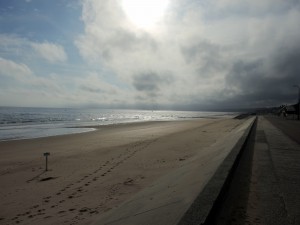
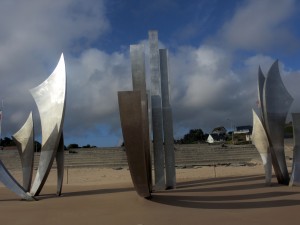
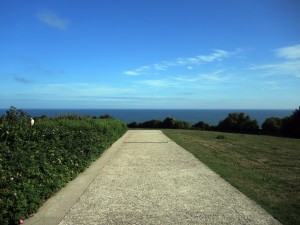
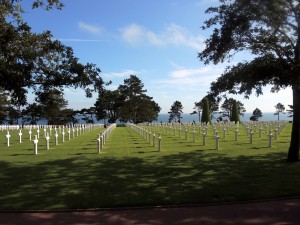
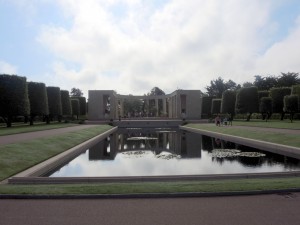
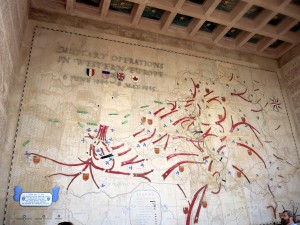
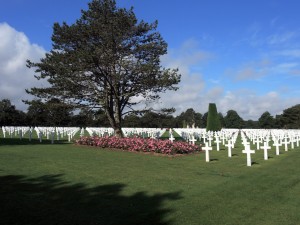
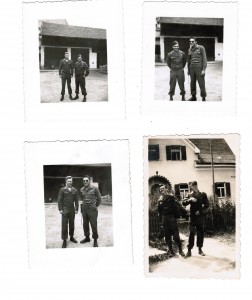







Brette, you write very movingly of the experience. I felt that strange mystical attachment at the beaches we visited. I actually felt the cries of despair by the youngsters who were struggling up those beaches. I liked that it was all very simple. The countryside around is not littered with souvenir shops and signs. We took a one day bus tour, and perhaps the guide helped us visualize the action more specifically, but you captured the feeling very well.
There is definitely absolutely nothing there – no shops, no restaurants, nothing. Someone I know said it’s almost as if the French want to just forget the whole thing happened.
If / when we make it to France, this is definitely somewhere I’d like to visit. I think I’m glad it isn’t all developed and overtly touristy. It would seem kind of crass, otherwise.
It is funny sometimes how places that you expect to be big tourist attractions simply aren’t. Loch Ness is another example of this. It’s just this quiet lake in the middle of nowhere. There are two tacky museums and absolutely nothing else.
Lovely post. My grandfather lied about his age to enlist for WWII as well. He ended up as a gunner in the Pacific. He was in the Bay of Tokyo curing the surrender, but not on the USS Missouri.
My son is very interested in WWII history, and this is top on his list of places to visit. I’m sharing this with him. (and your reference to those soldiers as boys? So true.)
I have been there several times. I walked the beach and my historian husband reminded me that on D-Day, the water was red with blood. I, too, found the cemetery very moving.
It is hard to imagine what that beautiful beach must have looked like on that day. Really an amazing place to go to and try to wrap your mind around.
Beautiful post, Brette – so moving.
My dad also lied about his age and enlisted in the Army at age 16. He didn’t see combat during WWII, he was an Army cook in Alaska, but was due to be shipped out for the Pacific if the U.S. found it necessary to invade Japan. I would love to see this, it sounds like an awesome trip.
So glad that you got to go to Omaha Beach and that it was more than just a stop on your trip, but something you truly experienced.
I went there about thirteen years ago. It was extremely quiet and moving and very solemn. My husband was the one who planned our trip there, and I wasn’t that excited to go, but am really glad I did in the end.
It’s sad enough to commemorate the deaths in a “good” and necessary war like WWii. But at least these men died for something — unlike the casualties of our more recent wars.
I have no idea how I will feel if and when I ever visit the 9/11 memorial. Honestly, I’m not sure it’s something I want to see.
What a moving trip this must have been.
This would be such a moving place to visit. Lovely story, Brette.
It looks like an achingly beautiful place. What an amazing experience.
What a powerful post. I’ve never been to Normandy but it’s long been on my list. And I’ll surely have to visit these sights.